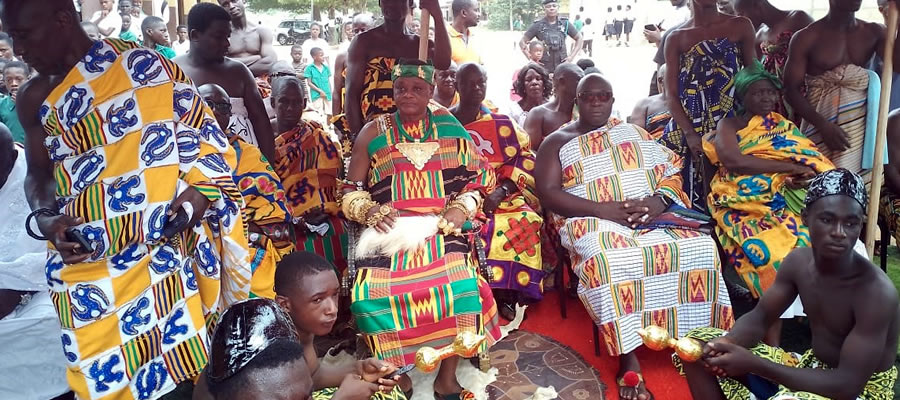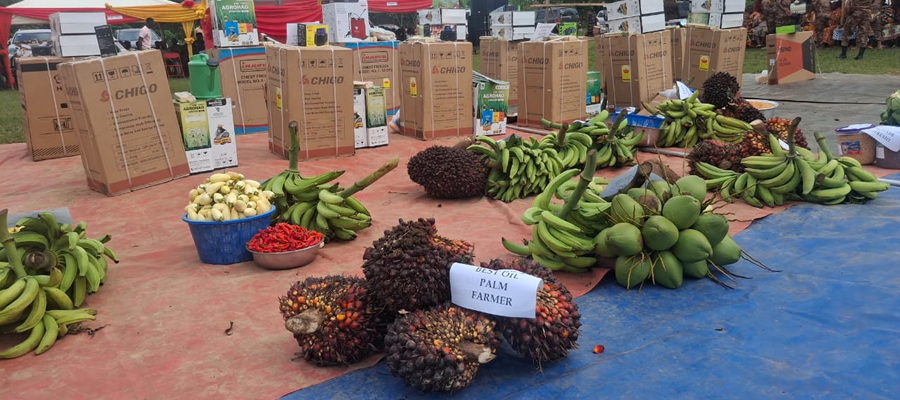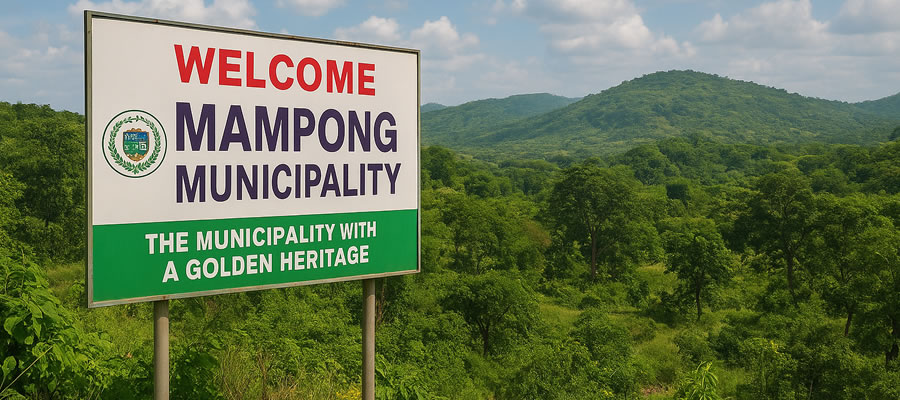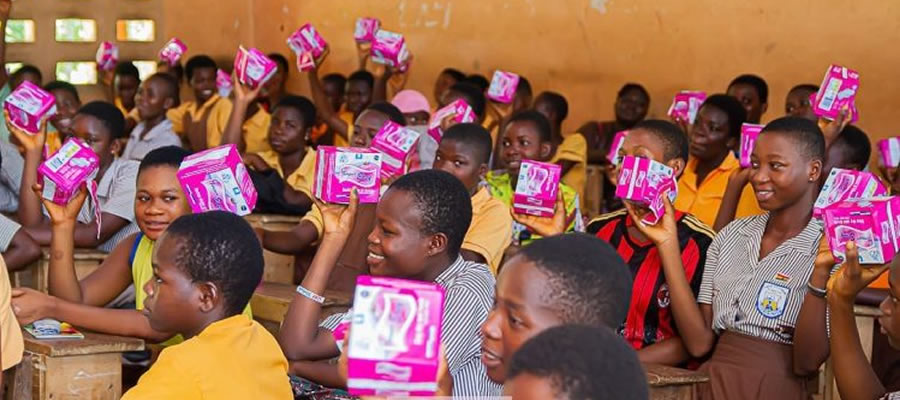
Introduction
Agriculture is an important economic activity in Ghana, involving the majority of the economically active population. It supports the economy in foreign exchange earnings and gross domestic product (GDP). This chapter discusses the households engaged in farming activities, crops cultivated and trees grown, type of cropping and acreages, type of livestock reared, numbers, and fish farming.
Agricultural Households
Table 11.1 shows that there are 412,055 agricultural households in the Ashanti Region, representing 16.5 percent of total agricultural households in the country. As a proportion of all households in the region, agricultural households form 36.6 percent. The average agricultural household size is 4.9 compared with an average household size of 4.2 for the region, suggesting that agricultural households are relatively larger. About 34.8 percent of agricultural households have 1-3 persons, 38.9 percent have 4-6 persons, 19.0 percent have 7-9 and the remaining 7.3 percent have 10 persons and more.
In the urban areas, 35.4 percent have 1-3 persons in a household, 38.4 percent have 4-6 persons and the remaining 26.2 percent have 7 and more persons. The average household size is 5.0. In the rural areas, 34.7 percent have 1-3 persons, 39.2 percent have 4-6 persons and the remaining 26.2 percent have 7 and more persons. The average household size is 4.9. Thus, the urban agricultural households are slightly larger than the rural agricultural households
In the districts, the highest proportion of agricultural households is in Amansie Central (85.3%) and the lowest is in Kumasi Metropolis (8.0%). In 18 of the districts, the proportions exceed 60 percent, and they are between 40 percent and 60 percent in four districts and below 40 percent in the remaining five districts.
Agricultural households in urban areas form a minority of 16.4 percent of total households, whereas in the rural areas they form a substantial majority of 71.8 percent of total households. The district with the highest proportion of urban agricultural households is Sekyere Afram Plains (73.0%), followed by Amansie Central (70.3%). In 11 districts, the proportions are between 50.0 percent and 70.0 percent. In four districts, the proportions are between 30.0 percent and 50.0 percent. In the remaining nine districts excluding Bosome Freho which has no urban area, the proportions are below 30.0 percent, with the lowest in Kumasi Metropolis (8.0%), followed by Kwabre East (13.6%), Afigya Kwabre (16.9%) and Obuasi Municipal (17.7%), all below 20.0 percent.
The proportion of rural agricultural households is highest in Offinso North (89.8%), followed by Sekyere Afram Plains (88.9%), Adansi South (88.7%) and Atwima Mponua (88.3%). In seven other districts, the proportions exceeded 80.0 percent. In eight districts, the proportions are between 70.0 percent and 80.0 percent. In three districts, the proportions are below between 50.0 percent and 70.0 percent. In the remaining four districts excluding Kumasi Metropolis which has no rural area, the proportions are below 50.0 percent. The lowest proportion is in Kwabre East (26.5%), followed by Atwima Kwanwoma and Atwima Nwabiagya (42.1% each) and Afigya Kwabre (44.3%).
Members of Agricultural Household
Table 11.2 shows the distribution of agricultural household members who are engaged in farming activities by sex and locality. The total number of household members in agriculture is 767,942. In the region as well as in the urban and rural areas, the proportions of males and females who are in farming activities are approximately 51 percent and 49 percent, respectively. In the districts, the proportions of males exceed those of females in 15 districts, and in the remaining 12 districts, the proportions of females are higher.
In the urban areas, the number of household members in farming activities is 214,027 or 27.9 percent of the regional total. In the urban areas, males (51.5%) are more than females (48.5%). In 15 districts, the proportion of males exceeds that of females and in the remaining 11 districts, the proportion of females is higher. In the rural areas, the number of household members in farming are 553,915 or 72.1 percent of the regional total. Again, the proportion of males (51.1%) is higher than that of females (48.9%). In 13 districts, the proportion of males is higher than that of females and, in the remaining 12 districts, the proportion of females is higher.
Heads of Agricultural Households
Table 11.3 shows the heads of agricultural households by sex and type of locality. The heads of the agricultural households in the region are predominantly male (67.2%). The female heads are 32.8 percent. In the urban areas, the male heads are 63.6 percent and the female heads are 36.4 percent, while in the rural areas, the male heads are relatively more than in the urban areas (68.6%) and the female heads are relatively fewer (31.4%).
The proportion of male heads is higher than that of female heads by a margin of 2 to 1 in many of the districts. The proportions in the districts and in the urban and rural localities are quite similar, approximately, two-thirds male and one-third female. Female heads exceed 40 percent in three districts, namely, Sekyere East (42.6%), Bosomtwi (41.7%) and Kwabre East (41.4%). The highest proportion of male heads is in Ahafo Ano North (77.0%) and, in nine districts, the proportion of male heads exceeds 70 percent. In nine districts, female heads of household are below 30 percent.
The proportion of urban male heads exceeds 70 percent in two districts, namely, Ejura-Sekyedumase (72.8%) and Obuasi Municipality (70.7%). In 16 districts, the proportion of male heads exceeds 60 percent, while the proportion of female heads in those districts is below 40.0 percent.
In the rural areas, the proportion of male heads is highest in Ejura-Sekyedumase (79.4%) and lowest in Bosomtwi (58.2%). The proportion exceeds 65 percent in 18 districts. In these districts, the proportion of female heads is below 35 percent. The proportion of female heads exceeds 40 percent in only three districts, namely, Kwabre East (43.3%), Bosomtwi (41.8%) and Sekyere East (40.9%).
Table 11.4 shows the distribution of heads of agricultural households by age and locality. About 11 percent of heads are below 30 years of age, 45.5 percent are between 30 years and 50 years of age, 26.5 percent are between 50 years and 65 years of age, and the remaining 17.0 percent are 65 years and older.
In urban areas, the proportion of heads aged below 30 years is 10 percent compared with 11.3 percent in rural areas. Those aged between 30 years and 50 years are 44.1 percent in urban areas, slightly less than their counterparts in rural areas who are 46.1 percent. The heads whose ages are from 50 years to 65 years are 28.3 percent in urban areas, slightly more than the 25.8 percent of those in that age group in rural areas. The proportion of heads aged 65 years and older in urban areas is 17.4 percent, also slightly more than their counterparts among heads in the rural areas who are 16.8 percent.
Household Farming Activity
Household farming activities are recorded in the 2010 Population and Housing Census with regard to crop farming, tree growing, livestock rearing and fish farming. Figure 11.1 shows the distribution of agricultural households in the region engaged in these activities. Including double counting (many households are in more than one activity), 96.8 percent of the households are in crop farming, 25.4 percent in livestock rearing, 0.8 percent in tree growing and 0.1 percent in fish farming. In crop farming, the proportion in the Ashanti Region exceeds the national average (95.1%) and in the other farming activities the national averages (40.5% in livestock rearing, 1.1% in tree growing and 0.2% in fish farming) exceed the averages in Ashanti Region (GSS, 2012).
Table 11.5 shows the distribution of types of farming in the districts. The proportion of households in crop farming is highest in Offinso North (99.3%) and lowest in Kumasi Metropolis (89.7%). In the other districts, the proportions exceed 90 percent. The proportion of households in livestock rearing is highest in Asante Akim South (42.4%), followed by Bosome Freho (41.2%). In eight districts, the proportions are between 30.0 percent and 40.0 percent.
In another six districts, the proportions are between 20.0 percent and 30.0 percent. In the remaining 11 districts, the proportions are below 20 percent, with the lowest in the Kumasi Metropolis (12.7%), followed by Atwima Kwanwoma (16.2%) and Amansie West (16.6%). The proportion of households in tree growing is highest in the Kumasi Metropolis (3.1%) and lowest in Bosome Freho (0.24%). In the other districts, the proportions are mostly below 0.5 percent. In fish farming, the highest proportion is again in Kumasi Metropolis (0.3% or 122 households) and lowest in Sekyere Central (0.02% or two households). In 13 districts, fewer than 10 households are engaged in fish farming.
Table 11.6 shows the distribution of agricultural households engaged in farming activities by sex of head of household. The proportion of male-headed and of female-headed households in the region engaged in crop farming is 67.2 percent male and 32.8 percent female. For those engaged in tree growing, the proportions are 67.1 percent male and 32.9 percent female. The proportions of male-headed and female-headed households engaged in livestock rearing are 73.4 percent male-headed households and 26.6 percent female-headed households. In fish farming, the proportion of male-headed households is much higher than that of female-headed households, 84.2 percent against 15.8 percent.
Table 11.6 shows that in the districts, the proportion of female-headed households in crop farming is 40 percent and a little higher in five districts, namely, Kwabre East (43.0%), Sekyere East (42.8%), Afigya Sekyere (42.7%), Bosomtwi (42.2%) and Atwima Kwanwoma (40.0%). In 14 districts, the proportions are between 30 percent and 40 percent, and in the remaining eight districts, the proportions are below 30 percent. The proportion of male-headed households exceeds 70 percent in eight districts. In another 15 districts, the proportions are between 60 percent and 70 percent. In the remaining four districts, the proportions are between 50 percent and 60 percent.
The proportion of female-headed households in livestock rearing is between 30 percent and 40 percent in eight districts. In another 15 districts, the proportions are between 20 percent and 30 percent and in the remaining four districts, the proportions are between 15 percent and 20 percent. In male-headed households, the proportion exceeds 80 percent in four districts, namely, Offinso North (84%), Ejura-Sekyedumase (81.5%), Ahafo Ano North (81.5%) and Ahafo Ano South (80.8%). In another 14 districts, the proportions are between 70 percent and 80 percent and in the remaining nine districts, the proportions are between 60 percent and 70 percent.
The proportion of female-headed households in tree growing is 52 percent in Kwabre East, and exceeds 40 percent in Atwima Kwanwoma (43.8%), Amansie West (42.6%) and Afigya Sekyere (40.6%). In 13 districts, the proportions are between 30 percent and 40 percent, in six districts they are between 20 percent and 30 percent and in the remaining four districts they are between 10 percent and 20 percent. The proportion of male-headed households in tree growing exceeds 80 percent in three districts, namely, Bosome Freho (88.0%), Atwima Mponua (82.9%) and Adansi South (80.4%). In six districts, the proportions are between 70 percent and 80 percent, and in 14 districts, they are between 60 percent and 70 percent. In the remaining districts, the proportions exceed 50 percent except in Kwabre East which is 48 percent.
Crop Farming
Crops Cultivated and Number of Farms
Table 11.7 shows that many crops and forest trees are grown in the region. There are 1,087,342 farms in the region, representing 16.4 percent of the 6,625,828 farms in Ghana. Among the crops, the proportion of cocoa farms is highest (22.1%), followed by cassava farms (21.6%), plantain farms (20.1%), and maize farms (11.3%). The maize farms are not many largely because their minor season coincided with the 2010 census. In the minor season, many farmers do not cultivate maize due to a high risk of crop failure as a result of inadequate and fluctuating rainfall patterns. The major tree crops in terms of number of farms after cocoa are oil palm and citrus, and far behind are cola, apples, mango, avocado and coffee.
Among the starchy crops consumed mainly in the country, the most important is cassava, followed closely by plantain, distantly by cocoyam and yam, and far behind by banana. Maize is the most important cereal crop cultivated in the region, followed distantly by rice, millet and sorghum (only 47 farms). Among the vegetables produced mainly for domestic consumption, pepper and tomato have twice as many farms as does okro and even more than garden eggs and onions. Beans are the most important pulse, followed by groundnuts; peas and soya beans are also cultivated. The number of farms for pineapple and pawpaw cultivation is relatively small, 1,188 farms and 759 farms, respectively
Date Created : 7/27/2023 12:00:00 AM












 facebook
facebook
 twitter
twitter
 Youtube
Youtube
 +233 593 831 280
+233 593 831 280 0800 430 430
0800 430 430 GPS: GE-231-4383
GPS: GE-231-4383 info@ghanadistricts.com
info@ghanadistricts.com Box GP1044, Accra, Ghana
Box GP1044, Accra, Ghana